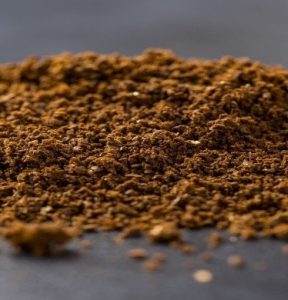What is silicon dioxide – E551?
The additive E551, silicon dioxide, is an anti-caking substance, used for clarification and stabilisation. Silicon dioxide is the chemical formula of a group of inorganic polymers where each silicon atom is surrounded by 4 tetrahedrally arranged oxygen atoms. The average stoichiometric composition of the compound is SiO2.

The IUPAC name is silicon dioxide. It is also known as silicon oxide, aerosil, silica, silicon dioxide.
The molecular mass of silicon dioxide is 60.6 g/mol.
Which foods contain the food additive E551?
Silicon dioxide, E 551 can be found in the following foods and ingredients:
– starter formulas, follow-on formulas, foods based on processed cereals and foods for infants and young children, these may contain the substances E414 (gum acacia, gum arabic) and E 551 (silicon dioxide) resulting from the addition of preparations nutrients containing at most 150 g/kg substance E 414 and 10 g/kg substance E 551 as well as substance E421 (mannitol) used as a support for vitamin B(12) (at least one part vitamin B(12) for 1000 parts mannitol ),
Read too:E950 Acesulfame K
– flavors (the maximum allowed dose is 50g/kg),
– dehydrated food powders (including sugars) – 10g/kg,
– emulsifiers and dyes, max. 5%,
– dehydrated cereals, 2 g/kg,
– matured cheese, including the rind,
-dry whey and whey products, except whey cheeses, 10000 mg/kg,
– powdered sugar, powdered dextrose, 15000 mg/kg,
– salt and substitutes,
– complementary foods for infants and young children 2000 mg/kg,
– coffee, coffee substitutes, tea, herbal infusions and other hot cereals and cereal drinks, except for cocoa,
– food additives to which the carrier substance can be added: emulsifiers and colorants, quantum satis,
Read too:E122 – Azorubine
– preparations of dyes in the form of dry powder, 50 000 mg/kg in the preparation,
– preparations of emulsifiers in the form of powders, 50 000 mg/kg in the preparation,
– polyol preparations in the form of dry powder 10000 mg/kg in the preparation,
– all flavors, 10 mg/kg in flavors,
– in dry powder preparations of all nutrients – 50,000 mg/kg in dry powder preparation (individually or in combination),
Read too:E407 – Caragenan
– food additives, including support substances from food enzymes, 50 000 mg/kg in the preparation in the form of dry powder.
Where is silicon dioxide found? How is it obtained?
Silicon dioxide is the most abundant mineral in the earth’s crust, because sand is composed of silica. It is found in nature in three forms: crystalline, polymorphic and various amorphous or microcrystalline forms.
Silica is found in combinations in gemstones:
– silicon dioxide, SiO2 , in its amorphous state is the common sand, and crystallised in a trigonal system, it is known as quartz, amethyst, onyx, etc;
– hydrated SiO2 forms opal,
Read too:E 211 – Sodium Benzoate
– quartz is a fairly common nontempered stone in the earth’s crust, with the chemical formula SiO2. Depending on the conditions under which it was formed (temperature, pressure, presence of foreign ions), quartz has several varieties, some of which are coloured.
– Agate and onyx are minerals containing 90-96% SiO2 with numerous inclusions; agate is found in pastel colours (yellow, pink, brown, laid down successively), and onyx, white with black laid down alternately, concentrically.
Silicon dioxide is obtained by acidifying a solution of sodium silicate in water. Unstable silicic acid is formed, which on removal of water forms a colloidal solution from which hydrated SiO2 precipitates. The substance occurs as translucent granules or as a powder with a porous surface and pores of various sizes. After drying it contains 4% water. The adsorption capacity of silica gel varies according to how the gel is obtained, according to the concentration of the solution from which it was precipitated or according to the reaction temperature or pH of the wash water.
What other products does silicon dioxide, E551, occur in?
Due to its uses in multiple industries, silicon dioxide can also be used in the following products:
– Medicines,
– Food supplements,
– Toners for printers,
– Varnishes,
– Plastics,
Read too:E415 – Xanthan Gum
– Cosmetics including toothpaste,
– Insecticides,
– Acaricides,
– Biomedical applications and
– Cleaning products.
Are there any side effects from consuming the food additive E551?
Since silicon dioxide is found in plants and drinking water, it is safe. It is known that the silicon we consume through diet does not accumulate in the body, it is eliminated by the kidneys.
There is no evidence so far that the additive E551 used in current quantities in the food and pharmaceutical industry is toxic.
Some studies suggest that there is no cause for concern when people consume silicon dioxide in normal doses, i.e. in the small amounts that manufacturers put in food.
According to EFSA, in animal studies, researchers found that there was no accumulation of silicon after animals repeatedly ate silica.
Silicon dioxide, E551, does not raise a genotoxicity concern.
Although there is no indication of toxicity of E551 at reported use levels, the European Food Safety Authority (EFSA) has urged the European Union (EU) to re-evaluate the safety of silicon dioxide (E551) when used as a food additive.
Read too:E129 – Alura AC
This re-evaluation is because animal studies have suggested that nano-sized particles can cause inflammatory reactions of the intestinal wall. These findings have not been shown to apply to humans. EFSA has warned that some of the silicon dioxide particles may be smaller than the nano threshold of 100 nm and has asked the EU to amend the current specifications to include specifications on particle size as well as particle distribution.
What are the characteristics of silicon dioxide – E551?
Silicon dioxide is an amorphous substance, produced either synthetically or by a vapour-phase hydrolysis process, yielding pyrogenic silica. The dry process produces silica precipitate, silica gel or hydrated silica.
Pyrogenic silica is mainly obtained in the anhydrous state, while the other products in the wet process are obtained as hydrates or contain water absorbed at the surface.
Assay: after calcination must not contain less than 99,0 % (fumed silica) or 94,0 % (hydrated forms).
It comes in the form of a white, fluffy powder or granules. It is hygroscopic.
Why is it necessary to use silicon dioxide?
The need to use silicon dioxide comes from the fact that it is an absorbent with a high capacity to retain vapours, gases or even various impurities present in some food products. For example, it is used in beer because it absorbs the high molecular proteins responsible for clouding the finished product. This treatment does not affect foam stability, colour or taste of the product.
The additive is also used in some food products as a carrier for colours and antifoams as well as a drying agent.
Silicon dioxide is used as an anti-caking agent to avoid lumps. In dietary supplements, this additive is used to prevent various ingredients from sticking together in powder form.
What are food additives?
According to Regulation (EC) No 1333/2008 of the European Parliament and of the Council, “Food additives” are substances that are not normally consumed as food on their own, but are deliberately added to food for technological purposes, such as preservation. However, substances used to impart flavour and/or taste or for special nutritional purposes, such as salt substitutes, vitamins and minerals, are not considered food additives.
In addition, substances considered as foodstuffs that can perform a technological function, such as sodium chloride or saffron for colouring, as well as food enzymes, should also not fall within the scope of this Regulation. However, preparations obtained from foodstuffs and other material sources, which are intended to achieve a technological effect in the final food product and which are obtained by the selective extraction of components (e.g. pigments) relating to the nutritive and flavouring components, should be considered as additives for the purposes of this Regulation.
Conclusions and Legislative Regulations – E551
In accordance with Commission Regulation (EU) 2017/1271 of 14 July 2017 amending Annex III to Regulation (EC) No 1333/2008/EC of the European Parliament and of the Council, as regards the use of silicon dioxide (E551) in combination with potassium nitrate (E252), “the Scientific Committee on Food has established an ‘unspecified’ acceptable daily intake (ADI) for silicon dioxide (E551) and certain silicates (e.g. sodium, potassium, calcium and magnesium silicates) when used as anti-caking agents”.
This assumes that silicon dioxide (E551) does not present a hazard to health when used at levels necessary to achieve the desired technological effect.
Additional consumer exposure to silicon dioxide (E551) when used as an anti-caking agent in potassium nitrate (E252) would remain limited.”
Bibliographical references
STANDARDS of 18 June 2002 on food additives for use in foodstuffs for human consumption, http://legislatie.just.ro/Public/DetaliiDocument/241478
GENERAL STANDARD FOR FOOD ADDITIVES CODEX STAN 192-1995 https://www.fao.org/fao-who-codexalimentarius/shproxy/ar/?lnk=1&url=https%253A%252F%252Fworkspace.fao.org%252Fsites%252Fcodex%252FStandards%252FCXS%2B192-1995%252FCXS_192e.pdf
http://ro.silica-factory.com/info/what-is-silicon-dioxide-in-supplements-23495778.html
https://www.efsa.europa.eu/en/efsajournal/pub/5088
https://wro.waykun.com/articles/dioxid-de-siliciu-e551-descriere-utilizari-si.html
Commission Regulation (EU) No 231/2012 of 9 March 2012 laying down specifications for food additives listed in Annexes II and III to Regulation (EC) No 1333/2008 of the European Parliament and of the Council Text with EEA relevance, EUR-Lex – 32012R0231 – EN – EUR-Lex (europa.eu)
EUR-Lex – 32012R0231 – EN – EUR-Lex (europa.eu)
Regulation (EC) No 1333/2008 of the European Parliament and of the Council https://eur-lex.europa.eu/legal-content/RO/TXT/PDF/?uri=CELEX:02008R1333-20160525&from=FR
https://eur-lex.europa.eu/legal-content/RO/TXT/PDF/?uri=CELEX:32017R1271&from=HR
Author: dr.ing.Fulvia Ancuța Manolache

